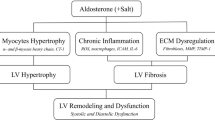Summary
This study aimed to determine whether aldosterone could induce vascular cell apoptosis in vivo. Thirty-two male rats were randomly divided into 4 groups: vehicle (control), aldosterone, aldosterone plus eplerenone or hydralazine. They were then implanted with an osmotic mini-pump that infused either aldosterone or the vehicle. Systolic blood pressure (SBP) was measured weekly by the tail-cuff method. After 8 weeks, plasma aldosterone concentration (PAC) and renin activity (PRA) were determined by radioimmunoassay. Aortic apoptosis was examined by TUNEL assay. The levels of cytochrome c and caspase-3 were determined by Western blotting and the expression of Bax and Bcl-2 was detected by immnuohistochemistry and Western blotting. The results showed that as compared with control group, aldosterone-infused rats exhibited: (1) an increase in SBP; (2) significantly elevated PAC with depressed PRA; (3) elevated aortic vascular cell apoptosis accompanied with higher levels of cytochrome c and activated caspase-3; and (4) significantly up-regulated Bax protein with down-regulated Bcl-2. These effects of aldosterone were significantly inhibited after co-administration with eplerenone but not with hydralazine. It was concluded that aldosterone induced vascular cell apoptosis by its direct effect on the aorta via mineralocorticoid receptors and independently of blood pressure, which may contribute to aldosterone-mediated vascular injury.
Similar content being viewed by others
References
Milliez P, Girerd X, Plouin PF, et al. Evidence for an increased rate of cardiovascular events in patients with primary aldosteronism. J Am Coll Cardiol, 2005, 45(8):1243–1248
Amano T, Matsubara T, Izawa H, et al. Impact of plasma aldosterone levels for prediction of in-stent restenosis. Am J Cardiol, 2006,97(6):785–788
Pitt B, Remme W, Zannad F, et al. Eplerenone, a selective aldosterone blocker, in patients with left ventricular dysfunction after myocardial infarction. N Engl J Med, 2003,348(14):1309–1321
Fuller PJ, Young MJ. Mechanisms of mineralocorticoid action. Hypertension, 2005,46(6): 1227–1235
Hatakeyama H, Miyamori I, Fujita T, et al. Vascular aldosterone. Biosynthesis and a link to angiotensin II-induced hypertrophy of vascular smooth muscle cells. J Biol Chem, 1994,269(39):24 316–24 320
Funder JW, Pearce PT, Smith R, et al. Vascular type I aldosterone binding sites are physiological mineralocor-ticoid receptors. Endocrinology, 1989,125(4):2224–2226
Hatakeyama H, Inaba S, Takeda R, et al. 11beta-hydroxysteroid dehydrogenase in human vascular cells. Kidney Int, 2000,57(4):1352–1357
Callera GE, Touyz RM, Tostes RC,et al. Aldosterone activates vascular p38MAP kinase and NADPH oxidase via c-Src. Hypertension, 2005,45(4):773–779
Hirono Y, Yoshimoto T, Suzuki N, et al. Angiotensin II receptor type 1-mediated vascular oxidative stress and proinflammatory gene expression in aldosterone-indued hypertension: the possible role of local renin-angiotnsin system. Endocrinology, 2007,148(4): 1688–1696
Iglarz M, Touyz RM, Viel EC, et al. Involvement of oxidative stress in the profibrotic action of aldosterone. Interaction with the renin-angiotension system. Am J Hypertens, 2004,17(7):597–603
Lopez-Candales A, Holmes DR, Liao S, et al. Decreased vascular smooth muscle cell density in medial degeneration of human abdominal aortic aneurysms. Am J Pathol, 1997,150(3):993–1007
von der Thusen JH, van Vlijmen BJ, Hoeben RC, et al. Induction of atherosclerotic plaque rupture in apolipoprotein E−/− mice after adenovirus-mediated transfer of p53. Circulation, 2002,105(17):2064–2070
Korshunov VA, Berk BC. Smooth muscle apoptosis and vascular remodeling. Curr Opin Hematol, 2008, 15(3): 250–254
Durand E, Scoazec A, Lafont A, et al. In vivo induction of endothelial apoptosis leads to vessel thrombosis and endothelial denudation: a clue to the understanding of the mechanisms of thrombotic plaque erosion. Circulation, 2004,109(21):2503–2506
Patni H, Mathew JT, Luan L, et al. Aldosterone promotes proximal tubular cell apoptosis: role of oxidative stress. Am J Physiol Renal Physiol, 2007, 293(4): F1065–1071
Mathew JT, Patni H, Chaudhary AN, et al. Aldosterone induces mesangial cell apoptosis both in vivo and in vitro. Am J Physiol Renal Physiol, 2008,295(1):F73–81
Hayashi H, Kobara M, Abe M, et al. Aldosterone nongenomically produces NADPH oxidase-dependent reactive oxygen species and induces myocyte apoptosis. Hypertens Res, 2008,31(2):363–375
Sharifi AM, Schiffrin EL. Apoptosis in aorta of deoxycorticosterone acetate-salt hypertensive rats: effect of endothelin receptor antagonism. J Hypertens, 1997, 15(12 Pt 1):1441–1448
Wei Y, Whaley-Connell AT, Habibi J, et al. Mineralocorticoid receptor antagonism attenuates vascular apoptosis and injury via rescuing protein kinase B activation. Hypertension, 2009,53(2):158–165
Lumachi F, Ermani M, Basso SM, et al. Long-term results of adrenalectomy in patients with aldosterone-producing adenomas: multivariate analysis of factors affecting unresolved hypertension and review of the literature. Am Surg, 2005,71(10):864–869
Struthers A, Krum H, Williams GH. A comparison of the aldosterone-blocking agents eplerenone and spironolactone. Clin Cardiol, 2008,31(4):153–158
Williams TA, Verhovez A, Milan A, et al. Protective effect of spironolactone on endothelial cell apoptosis. Endocrinology, 2006,147(5):2496–2505
Li Y, Song YH, Mohler J, et al. ANG II induces apoptosis of human vascular smooth muscle via extrinsic pathway involving inhibition of Akt phosphorylation and increased FasL expression. Am J Physiol Heart Circ Physiol, 2006,290(5):H2116–2123
Mercer J, Mahmoudi M, Bennett M. DNA damage, p53, apoptosis and vascular disease. Mutat Res, 2007, 621(1–2):75–86
Kutuk O, Basaga H. Bcl-2 protein family: implications in vascular apoptosis and atherosclerosis. Apoptosis, 2006,11(10):1661–1675
Oltvai ZN, Milliman CL, Korsmeyer SJ. Bcl-2 heterodimerizes in vivo with a conserved homolog, Bax, that accelerates programmed cell death. Cell, 1993, 74(4):609–619
Schnackenberg CG, Welch WJ, Wilcox CS. Normalization of blood pressure and renal vascular resistance in SHR with a membrane-permeable superoxide dismutase mimetic: role of nitric oxide. Hypertension, 1998,32(1):59–64
Munzel T, Kurz S, Rajagopalan S, et al. Hydralazine prevents nitroglycerin tolerance by inhibiting activation of a membrane-bound NADH oxidase. A new action for an old drug. J Clin Invest, 1996,98(6): 1465–1470
Sharifi AM, Schiffrin EL. Apoptosis in vasculature of spontaneously hypertensive rats: effect of an angiotensin converting enzyme inhibitor and a calcium channel antagonist. Am J Hypertens, 1998,11(9):1108–1116
Author information
Authors and Affiliations
Corresponding author
Additional information
The authors contributed equally to this work.
This project was supported by a grant from National Natural Sciences Foundation for Distinguished Young Scholar, People’s Republic of China (No. 30725040).
Rights and permissions
About this article
Cite this article
Yan, Y., Ouyang, J., Wang, C. et al. Aortic cell apoptosis in rat primary aldosteronism model. J. Huazhong Univ. Sci. Technol. [Med. Sci.] 30, 385–390 (2010). https://doi.org/10.1007/s11596-010-0362-3
Received:
Published:
Issue Date:
DOI: https://doi.org/10.1007/s11596-010-0362-3




